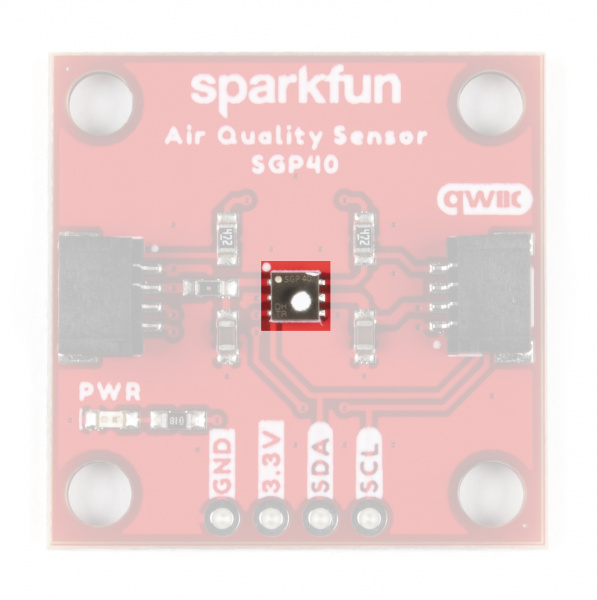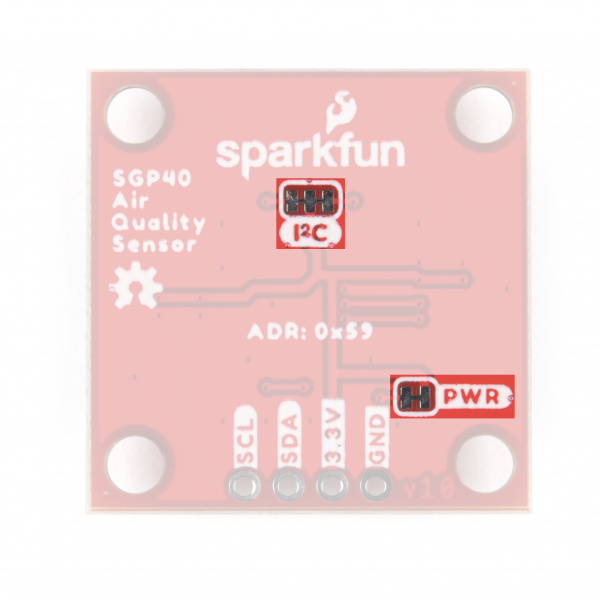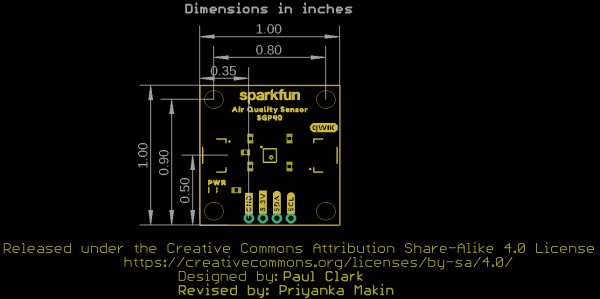Air Quality Sensor - SGP40 (Qwiic) Hookup Guide
Hardware Overview
In this section we'll cover the features and specifications of the SGP40 Air Quality Sensor as well as highlight other hardware present on this Qwiic breakout.
SGP40 Gas Sensor
The SGP40 air quality gas sensor from Sensirion offers an easy-to-integrate indoor air quality monitoring system with Sensirion's VOC Index. The SGP40 is an I2C device that outputs either a raw digital signal of all typical VOC gases present in an indoor environment or a processed VOC index value.
The SGP40's broad spectrum of sensing means it does not measure specific concentrations of individual VOC gases. Instead, the sensor outputs a digital signal sensitive to common indoor air pollutants/VOC gases[1]. Some common air pollutants the SGP40 detects are:
- Acetone
- Toluene
- Ethanol
- Hydrogen Sulfide & Volatile Sulfuric Compounds
- Ammonia & Amines
- Benzene & Nitrosamines
The raw signal can be read on its own but for best results, Sensirion's VOC Algorithm processes the signal to output VOC Index data. The processed VOC Index value ranges from 0 to 500 index points. The data is relative to the history of the monitored room where 100 is the average reading reported over the last 24 hours. Values above 100 signify a VOC event or worse-than-average air quality and values below indicate better-than-average air quality. The rate and intensity of change help identify the severity of the event to trigger actions such as turning on fans to ventilate the area until the signal stabilizes again.
The SGP40 accepts a supply voltage between 1.7V and 3.6V with this breakout intended to run at 3.3V to work with the Qwiic system. The SGP40 draws 34µA (typ.) while idling and 2.6mA@3.3V (typ.) during operation. Power is provied either over the Qwiic interface or through the pins labeled 3.3V and Ground on the 0.1"-spaced plated through hole (PTH) header.
I2C and Qwiic Interface
The SGP40 communicates via I2C so naturally we've routed that interface to a pair of Qwiic connectors for easy integration into SparkFun's Qwiic system. For users who prefer a more traditional interface, the SDA and SCL pins are routed to the same 0.1"-spaced PTH header as the 3.3V and GND pins.
The SGP40's I2C address is 0x59 and the IC supports both "standard-mode" and "fast-mode" with max clock frequencies of 100 or 400kHz, respectively.
Solder Jumpers
This breakout has two solder jumpers labeled PWR and I2C. The PWR jumper completes the power LED circuit and the I2C jumper pulls the SDA/SCL lines to 3.3V via a pair of 1kΩ resistors. Both jumpers' default state is CLOSED.
Disable the Power LED by severing the trace between the two pads. Opening this jumper helps reduce the total current draw of the breakout for low-power applications. Similarly, disable the pull-up resistors for the SDA/SCL lines by severing the trace between the three pads.
Board Dimensions
The Air Quality Sensor - SGP40 (Qwiic) matches the 1.0" x 1.0" (25.4mm x 25.4mm) standard of Qwiic breakouts and has two mounting holes that fit a 4-40 screw.



